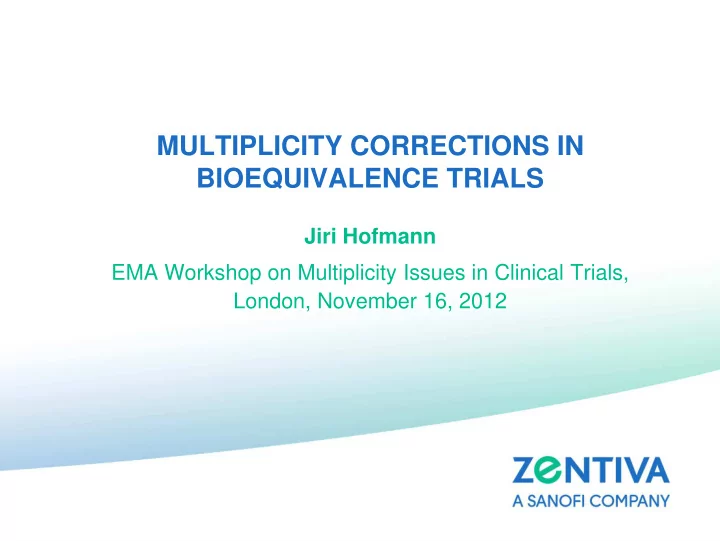

MULTIPLICITY CORRECTIONS IN BIOEQUIVALENCE TRIALS Jiri Hofmann EMA Workshop on Multiplicity Issues in Clinical Trials, London, November 16, 2012
BIOEQUIVALENCE TRIALS IN DRUG DEVELOPMENT ● Bridging the clinical (phase III) formulation with market formulation ● Generic formulation approval ● Major variations of approved product ● Lack of drug-drug or food-drug interactions
BIOEQUIVALENCE / PHASE I. STUDY ‚Two medicinal products containing the same active substance are bioequivalent if they are pharmaceutically equivalent or pharmceutical alternatives and their bioavailabilities (rate and extent) after administration of the same molar dose lie within acceptable predefined limits.‘ ‚The plasma concentration curve is generally used to assess the rate and extent of absorption.‘ C max (the maximum plasma concentration) AUC (the area under the concentration-time curve) Guideline on the Investigation of Bioequivalence (CPMP/EWP/QWP/1401/98 Rev.1/Corr)
BIOEQUIVALENCE STUDY DESIGNS Section 4.1.1. (Standard design) ‚Two-period, two-sequence cross-over design recommended ‘ (Alternative designs) ‚..the study design and statistical analysis scientifically sound, alternative design could be considered such as…‘ ● Parallel design ● Replicate cross-over (3-period and 4-period design) ● Sequential (two-stage) cross-over design Guideline on the Investigation of Bioequivalence (CPMP/EWP/QWP/1401/98 Rev.1/Corr) ● Cross-over design with more than two formulations
STUDY DESIGN/ 5 FORMULATIONS 5-period, open label, randomized, cross-over, single-dose in fasting conditions Study design: Williams design (10 sequences) Test A, B, C, D vs. Reference (E) Statistical analysis: ANOVA with effect of sequence, subject(sequence), period, formulation; confidence interval for test to reference (geometric mean) ratio Guideline on the Investigation of Bioequivalence (CPMP/EWP/QWP/1401/98 Rev.1/Corr)
STUDY DESIGN/ OBJECTIVE ‚It is vital that protocol of a trial designed to demonstrate equivalence or non-inferiority contain a clear statement that this is its explicit intention. An equivalence margin should be specified in the protocol;… ‘ Note for Guidance on Statistical Principles for Clinical Trials (CPMP/ICH/363/96) (5-way study) The objective of this study is to compare the rate and extent of absorption of Test formulations of ‚Molecule‘ (Test A, B, C, D) versus Reference formulation after a single oral dose administration under fasting conditions. If results are conclusive, they may be used as a proof of bioequivalence between and each Test and Reference product.
STUDY ANALYSIS/ ALPHA ADJUSTMENT ● Situation 1 (‚JOINT DECISION RULE‘) The aim of the study would be to show that all test formulations are bioequivalent to Reference product. ‚No adjustment of the type I error (alpha) is needed to keep the familywise type I error under control.‘ ● Situation 2 (‚MULTIPLE DECISION RULE‘) ‚The option to choose either one of the bioequivalent test formulations , the familywise type I error has to be adjusted.‘ Bonferroni, Holm, Hochberg correction(s) Dunnett procedure (incompatible with CHMP guideline) Hauschke, D., Steinijans, V. and Pigeot, I. (2007). Bioequivalence studies in drug development, Methods and Applications, Wiley; Dunnett, Ch. (1955). A multiple comparison procedure for comparing several treatments with a control, J Am Stat Assoc 50(272) Zheng, Ch. et al. (2012). Testing bioequivalence for multiple formulations with power and sample size calculation. Pharmaceutical Statistics 11
Q&A SYMPOSIUM/ LONDON 2010 SYMPOSIUM ON BIOEQUIVALENCE 5.5 ‚ A 3-way study with 2 test products (alternate lead formulations) may raise some questions with some medicines agencies . This may lead to alpha adjustments .‘ (multiple decision rule; Situation 2 ) ‚A more appropriate solution would always be to run 2 separate bioequivalence studies.‘ ● Situation 3 (‚NO ALPHA CORRECTION‘) ‚If there were 2 test products and the other formulation was for exploratory purposes e.g., solution or different form, then it may be acceptable to perform the study and remove this arm from the calculation. ‘ 3 rd EGA Symposium on Bioequivalence: Training on the New Revised EMA Guideline on the Investigation of Bioequivalence (CPMP/EWP/QWP/1401/98/Rev.1/Corr), Summary of the Questions and Answers Raised During the Symposium, 2010
COMMON/ SEPARATE VARIANCE ESTIMATE Section 4.1.8. ‚In studies with more than two treatment arms (e.g. EU/US reference product; fasting/fed study), the analysis for each comparison should be conducted excluding the data from the treatments that are not relevant for the comparison in question.‘ Guideline on the Investigation of Bioequivalence (CPMP/EWP/QWP/1401/98 Rev.1/Corr) OPTIONS Calculate separate ANOVA analyses with alpha correction based on Bonferroni, Holm, Hochberg…..(other methods?) Holm, S. (1979). A simple sequentially rejective multiple test procedure, Scand J Statist 6 Hochberg, Y. (1988). A sharper Bonferroni procedure for multiple tets of significance, Biometrika 75
ILLUSTRATIVE (RE)ANALYSIS 5-period, open label, randomized, cross-over, single-dose in fasting conditions 20 healthy adult male or female subjects (moderate smokers and/or non-smokers) Wash-out: 7 days Blood sampling: 0, 1, 1.5, 2, 2.5, 3, 3.5, 4, 4.5, 5, 5.5, 6, 7, 8, 12, 16, 24, 36, and 48 hours post-dose Statistical analysis: ANOVA with effect of sequence, subject(sequence), period, formulation for each comparison Calculations performed in Phoenix WinNonlin 6.3. (Pharsight) & in R (R Foundation for Statistical Computing, Vienna, Austria)
BONFERRONI vs. HOLM vs. HOCHBERG / C max TEST vs. REFERENCE (90% CORRECTED CI) relative bioavailability (%)
SUMMARY & CONCLUSION ● Requirement of ‚separate ANOVA‘ analysis (EMA Guideline of Investigation of Bioequivalence) is incompatible with Dunnett correction ● Corrections to preserve the type I error compatible with separate ANOVA analyses should be used: Bonferroni or Holm or Hochberg or…..(?) ● Method of Holm and Hochberg would be recommended as they are more powerful than Bonferroni Zheng et al., 2012 ● Guidance recommendation missing so far
MULTIPLICITY CORRECTIONS IN BIOEQUIVALENCE TRIALS Jiri Hofmann jiri.hofmann@zentiva.cz Clinical Development Manager EMA Workshop on Multiplicity Issues in Clinical Trials, London, November 16, 201
Recommend
More recommend